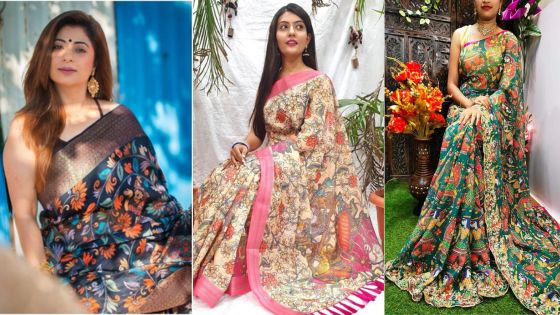Kalamkari saree is a type of traditional hand-painted saree that originates from Andhra Pradesh, India. The word “Kalamkari” is derived from the Persian words “kalam” (pen) and “kari” (craftsmanship), which literally means “pen-work”.
The process of making Kalamkari saree involves hand-painting and block-printing techniques using natural dyes and pigments. The fabric used for making Kalamkari saree is usually cotton or silk, and the designs can range from floral and nature-inspired motifs to mythological scenes and religious figures.
Kalamkari sarees are known for their vibrant colors, intricate designs, and eco-friendliness as they use natural dyes and organic fabrics. They are highly popular among women who appreciate traditional and handmade textiles.
Kalamkari saree is a traditional Indian saree that is made using the ancient Indian art of Kalamkari, which involves hand-painting or block-printing designs onto fabric using a special pen made of bamboo or date palm. The word “Kalamkari” is derived from the Persian words “kalam” (pen) and “kari” (craftsmanship), reflecting the intricate handwork involved in creating these sarees.
There are several different types of Kalamkari sarees by Chinaya Banaras, each with its own unique style, design, and technique. Here are a few examples:
There are two types of Kalamkari sarees:
- Srikalahasti style: This style of Kalamkari saree is named after the town of Srikalahasti in Andhra Pradesh, where the craft originated. The Srikalahasti style of Kalamkari involves intricate freehand drawing using a pen and natural dyes on cotton fabrics. The designs usually depict mythological scenes and figures from Hindu epics like the Ramayana and Mahabharata.
- Machilipatnam style: This style of Kalamkari saree is named after the town of Machilipatnam in Andhra Pradesh. In the Machilipatnam style, the designs are created by using wooden blocks to print the outlines of the design onto the fabric. Then, the artist uses a pen to fill in the details and colors using natural dyes. The designs in this style are usually more geometric and floral in nature.
Both styles of Kalamkari sarees are known for their intricate designs, vibrant colors, and eco-friendliness. They are popular among women who appreciate traditional and handmade textiles.
Kalamkari sarees offer several benefits, some of which include:
- Unique and Handmade: Kalamkari sarees are unique and handmade, each piece is one-of-a-kind, and no two sarees are exactly alike. They are created by skilled artisans who use traditional techniques passed down from generation to generation.
- Eco-Friendly: Kalamkari sarees are made using natural dyes and organic fabrics, which makes them eco-friendly and sustainable. They do not contain any harmful chemicals, making them safe to wear.
- Vibrant Colors: Kalamkari sarees are known for their vibrant colors, which are obtained from natural dyes. The colors do not fade easily and last for a long time.
- Versatile: Kalamkari sarees are versatile and can be worn for different occasions, from formal events to casual outings. They can be paired with different types of blouses, jewelry, and accessories to create unique looks.
- Cultural Significance: Kalamkari sarees have a rich cultural significance and are a reflection of the traditional art and craft of India. They are highly valued as a part of India’s cultural heritage and are often passed down from generation to generation as family heirlooms.
Overall, Kalamkari sarees offer a unique blend of art, culture, and sustainability, making them a popular choice among women who appreciate traditional and handmade textiles.




















